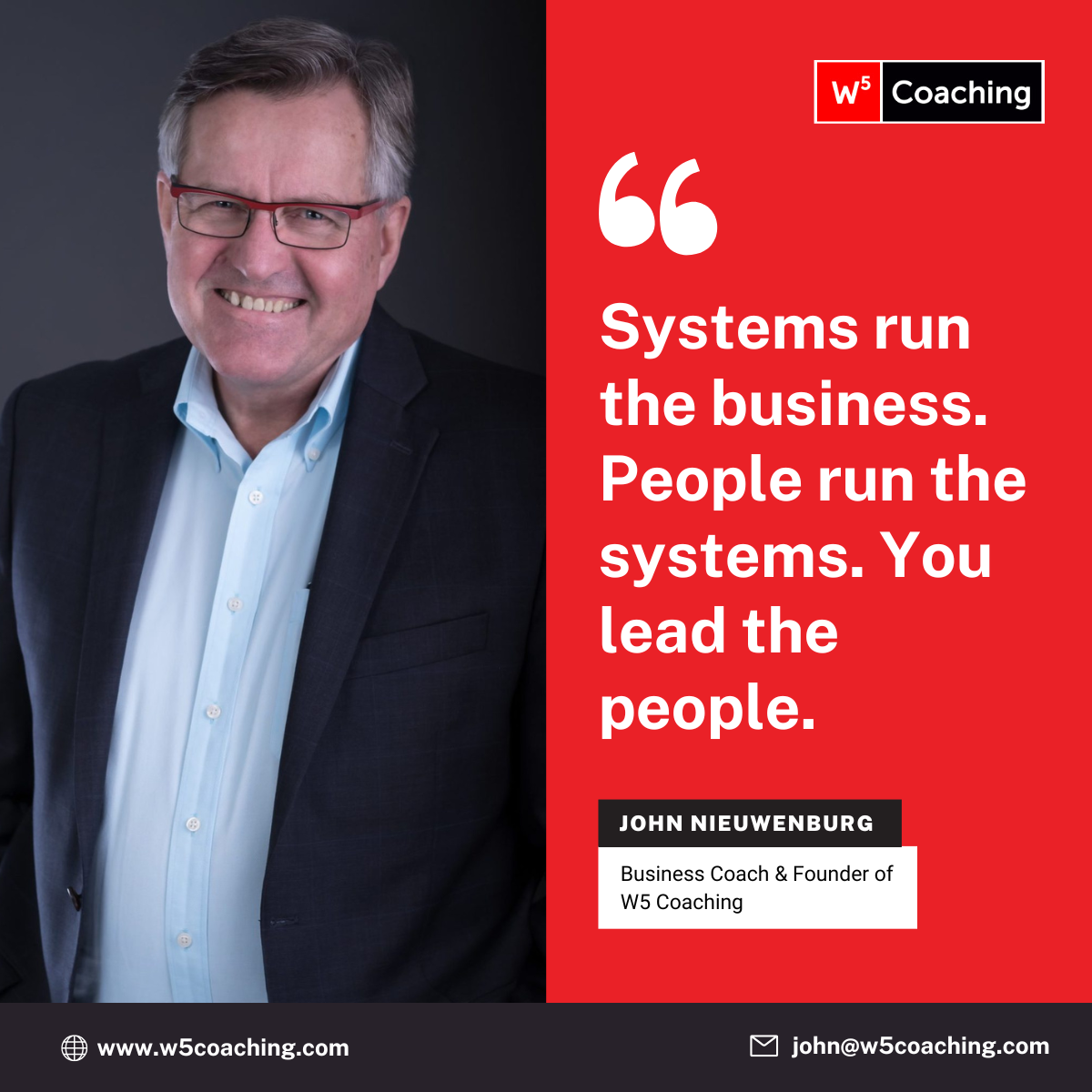Take Back Your Life: How to Develop Systems to Run your Business

Is your business taking over your life? You need systems.
Many of my clients come to me because they’re tired of having a business that completely consumes their life.
The way out of that trap is to build a self-managing business that runs efficiently without the owner’s constant involvement.
When you have a self-managing business, you can:
- Get out of the “hub and spoke trap” where everyone comes to you for every little thing.
- Achieve time freedom so that you can leave at a reasonable hour, take weekends off, or go on an extended vacation.
- Retire and have someone buy the business or run it while you draw income from it.
It’s also a critical part of growing and scaling.
At the heart of a self managing business is this often repeated W5 Coaching saying: “systems run the business, people run the systems, you lead the people.”
In other words…
You want your business to be systems dependent instead of people dependent
 When you create great systems in your business, you can hire people with a relatively low level of skill and experience to do the work at a high level.
When you create great systems in your business, you can hire people with a relatively low level of skill and experience to do the work at a high level.
Consider McDonald’s.
How do they get those french fries to taste the same?
Whether they’re made in Frankfurt, or Hong Kong, or your hometown, the French fries are made by a 16-year-old and the parents of that teenager can’t get him or her to clean their bedroom!
How do they do that?
They have great systems.
McDonald’s can train any 16-year-old to follow their process.
When you have systems in place, you’re no longer the bottleneck (the only person who can make a decision or who knows what’s going on.)
Your team knows what to do and how to do it.
They run the systems.
Your job is to lead those people.
Where to start when building systems for your business
So where do you start? Follow these 4 steps.
1. Identify and Prioritize Processes
Start by listing all the processes in your business. Essentially, what does everyone do? For example:
- How do you onboard new clients or customers?
- How do you handle complaints?
- How do you send invoices and reconcile accounts?
- How do you do your marketing?
- What is your sales process?
- How do you deliver your services?
- How do you hold meetings?
(Tip: conducting a Time Audit can help you uncover these.)
When you have your list, rank them based on frequency and importance.
Where would it make the most sense to start?
Pick one to get started.
Developing processes and systems for your business can be a big project.
Avoid overwhelm by breaking it into smaller chunks. You don’t need to do it all at once!
2. Document the Process by Creating Checklists and SOPs (Standard Operating Procedures)
When I suggest that my clients should create SOPs, they often picture having to create huge binders of “employee training manuals.”
That might be necessary if you want to create an actual franchise like McDonald’s, but for most small businesses, SOPs can be a lot simpler while still being very effective.
Here are 5 tips for getting the job done faster and easier.
- Use Video. Make a recording where you talk through the instructions. Keep videos to 3 minutes or less. If you need longer to explain something, break it into multiple steps.
- Have Employees Create Them. Whenever I give my VA a new task to perform for me, we get on a zoom call. She records the call while I give her the instructions. Then her first task is to document the instructions in our SOP document.
- Keep the Technology Simple. Google Drive is a great option: it’s easy to share, easy to access, and you can set permissions on individual documents if necessary.
- Start Small and Build Over Time. Begin with a simple checklist, then expand it to a full SOP if required.
- Include Visuals: Use screenshots or diagrams instead of lots of explanatory text.
3. Train Your Team
The intention behind creating systems is to ensure that things are done consistently.
If you want the right people doing the right things right – every team member should understand the system and how to execute it.
Making training on your systems part of your onboarding system.
If you’re creating new or updated systems, you may also need some refresher training for current staff members.
Your SOPs and checklists should be available where employees need them most. Google drive is a simple, cloud-based place to store and share.
Systems work best when they become part of your culture: they’re just “how we do things around here.” Everyone follows them and they are kept up to date.
4. Review, Update, and Refine your Systems Over Time
Gather feedback and refine your processes.
If you find a better way of doing things, update the document.
Systematize the routine and humanize the exceptions.
85% of what you do is routine. These are the things you do (or should do) the same way every time.
10% to 15% of what you do will be exceptions to the system.
In these cases, you’ll need to intervene in order to get things done.
Then, ask:
“How would the system need to be changed so that this exception doesn’t happen again?”
Over time, your systems will get better and better.
Let systems free you from your business
 Systems can help you to streamline your operations, reduce errors, and improve the overall quality of your work.
Systems can help you to streamline your operations, reduce errors, and improve the overall quality of your work.
They’re also the magic key that allows you to get out of the hub and spoke trap where everything has to come through you.
Contrary to popular belief, creating systems doesn’t require a grand strategic plan, a complicated documentation process, or months of thoughtful planning.
Instead, it’s about providing your team with practical guidance that will help them to complete tasks in a consistent and efficient manner.
By implementing systems, you’ll be able to scale your business, ensure consistency, and optimize your workflows.
Most importantly, you’ll set up your business to give you the life you want.
Developing systems is a worthwhile investment that will pay dividends in the long run.
If you’d like some support systematizing your business, let’s talk about coaching. You can book a call here: book a call with John

Build a Self-Managing Company
How to build a business that runs smoothly, profitably, and (mostly) without you.
Feeling stressed out and overwhelmed with a business that is taking all your time - and not giving you enough in return?
Are you finding it challenging to hire the right team (and get them to do the right things)?
I wrote this little guide for you!
Enter your details below to receive your free copy!
